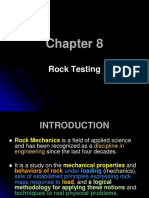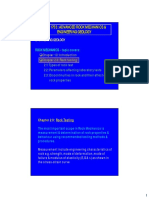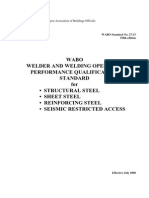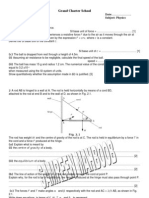The Tests For Index and Indirect Strength Test Include:: Lab 3 Amendme NT Da Te
The Tests For Index and Indirect Strength Test Include:: Lab 3 Amendme NT Da Te
Uploaded by
Noor NadiahCopyright:
Available Formats
The Tests For Index and Indirect Strength Test Include:: Lab 3 Amendme NT Da Te
The Tests For Index and Indirect Strength Test Include:: Lab 3 Amendme NT Da Te
Uploaded by
Noor NadiahOriginal Title
Copyright
Available Formats
Share this document
Did you find this document useful?
Is this content inappropriate?
Copyright:
Available Formats
The Tests For Index and Indirect Strength Test Include:: Lab 3 Amendme NT Da Te
The Tests For Index and Indirect Strength Test Include:: Lab 3 Amendme NT Da Te
Uploaded by
Noor NadiahCopyright:
Available Formats
FACULTY : CIV IL & ENVIRONME NTAL ENGINEE RING DEPARTME NT : GEOTECHNICAL & TRANSPORTA TION ENGINEE RING LABORA
TORY : ENGINEERING GEOLOGY & GEOPHYSIC LABORA TORY TOPIC : ROCK STRENGTH POI NT LOAD TEST (LAB 3)
NO. OF PAGES: EDITION: NO. OF CHECK ING: EFECTIVE DA TE : AMENDME NT DA TE:
i.
Describe generally the differences bet ween index and direct test.
a) INDE X TES T
Index test is relatively simple and rapid to conduct, but it does not provide fundamental property. The data obtained is just an indicator on property that being tested. The apparatus used are normally simple and portable which also allows the test to be conduct at site. The tests may not require some det ailed sample preparation where certain tests are non-destructive type and does not involve failure of samples (c ost saving for s ample could be reused). The data also not suitable for detailed design purposes but it is useful and valuable for preliminary or prefeasibility assessments.
The tests for Index and Indirect Strength test include:
I.
Point-Load Index Test It is a quick and simple test to conduct where the rock sample can be in core or irregular block. The equipment is easy to use and handle as test could be perform directly on site. Schmidt or Rebound Hammer Test
Schmidt or Rebound Hammer Test
It normally test on surface hardness of rock sample using the L-type as it is also easy to use and handle. The sample can be in core or block shape and it is non-destructive type of test where the sample can be reused again.
II.
Slake Durability Index Test
Slake Durability Index Test
This test is to assess the resistance of rock sample throughout weakening and disintegration when subjected to drying and wetting process, known as weathering process.
III.
Sonic Wave Velocity Test
Sonic Wave Velocity Test
This test is non-destructive and the equipment is portable. The test involves transmitting of primary-wave through core rock sample and the data obtained is wave propagation velocity.
IV.
Brazilian or Indirect Tensile Strength Test
Brazilian or Indirect Tensile Strength Test using the UTM equipment. The objective of this test is to measure uni-axial tensile strength of rock sample indirectly
FACULTY : CIV IL & ENVIRONME NTAL ENGINEE RING DEPARTME NT : GEOTECHNICAL & TRANSPORTA TION ENGINEE RING LABORA TORY : ENGINEERING GEOLOGY & GEOPHYSIC LABORA TORY TOPIC : ROCK STRENGTH POI NT LOAD TEST (LAB 3)
NO. OF PAGES: EDITION: NO. OF CHECK ING: EFECTIVE DA TE : AMENDME NT DA TE:
b) DIRE CT TEST
The test procedure requires detailed preparation of sample in terms of standard shapes and finishing. The sample preparation proc ess is equipment related and it is costly. The testing itself involving sophisticated and large equipment significant to the detailed testing procedures and may require complex analysis and this is also costly. However, the data obtained is the fundamental property and would be the direct present ation of property being evaluated. The numbers of t ests were limit ed due to its cost of operation and with this the data obtained can be use for detailed design.
The tests for Direct or Strength te st include:
i.
Uniaxial Compressive Strength Test
It requires a preparation of sample as accordance to ISRM (International Society of Rock Mechanics). Uniaxial compressive strength (UCS ) of rock material and deformation behavior under loading is verify by applying compressive load until failure using high capacity Univers al testing machine (UTM).
ii.
Triaxial Compressive Strength Test
Triaxial compressive test is a 3 dimensional compression which used to evaluate the strength of rock under confinement condition; example rock samples obt ained from deep seated rock mass.
Hook 's Cell used for Triaxial Compressive Strength Test
iii.
Shear Strength Test
Shear test is to evaluate shear strength and shear behavior of weakness plane in rock which is not shearing of the intact rock material. This is the most expensive laboratory strength tests, as it requires special kind of method for acquiring the samples from the site as fracture plane to be tested and utmost relatively complex testing procedures. The weakness planes shear strength, fractures and joints in rock mass is important for project which involves excavation in rock such as slope and tunnel.
Shear Strength Test
FACULTY : CIV IL & ENVIRONME NTAL ENGINEE RING DEPARTME NT : GEOTECHNICAL & TRANSPORTA TION ENGINEE RING LABORA TORY : ENGINEERING GEOLOGY & GEOPHYSIC LABORA TORY TOPIC : ROCK STRENGTH POI NT LOAD TEST (LAB 3)
NO. OF PAGES: EDITION: NO. OF CHECK ING: EFECTIVE DA TE : AMENDME NT DA TE:
ii.
Explain the discontinuities in rock and their effect on strength.
A discontinuity in geotechnical engineering (in geotechnical literature often denoted by joint) is a plane or surface that marks a change in physical or chemical characteristics in a soil or rock mass. A discontinuity can be, for example, a bedding, schistosity, foliation, joint, cleavage, fracture, fissure, crack, or fault plane. A division is made between mechanical and integral discontinuities. Discontinuities may occur multiple times wit h broadly the same mechanic al characteristics in a discontinuity set, or may be a single discontinuity. A discontinuity makes a soil or rock mass anisotropic.
v Di scontinuitie s in rock and their effect on strength
Strength of rock material and rock mass consist of compression (uni axial and tri-axial), tensile, shear (discontinuity planes) and ot her strength properties like fatigue and creep. Depending on the scale being considered (material or rock mass scale), the strength of rock is affected by the presence of discontinuities (big and small scale) in rock. The most important effect is strength reduction. For small laboratory rock sample, it is affected by minerals arrangement and how cleavage such as schistoscity in metamorphic rock.
Effect on floe cleavage (schistosity) on strengt h of rock material
On a larger scale, rock masses are affected by geological structures and discontinuities like bedding, joint and fault .
Scale effect transition from intact rock to heavily jointed rock mass with increasing sample size
The degree of strength reduction depends on loading orientation with respect to discontinuity planes. Figure shows the effect of single joint and multiple joint-set under different inclination of uniaxial compression.
The influence of weakness or discontinuity planes on strength, joint orientation with respect to loading axis
You might also like
- HIRARC Piling WorkDocument4 pagesHIRARC Piling Workhairul82% (11)
- Airbus VS Boeing Slide FinalDocument16 pagesAirbus VS Boeing Slide FinalNoor NadiahNo ratings yet
- Kompakt Recu: Series Air Handling Units With C2 Control System Electrical Installation and Operation ManualDocument20 pagesKompakt Recu: Series Air Handling Units With C2 Control System Electrical Installation and Operation ManualRamoNo ratings yet
- Torque Converter Lockup SwitchDocument2 pagesTorque Converter Lockup SwitchKenny G Nichol100% (1)
- Co Relation Between Point Load Strength Index, Uni-Axial Compressive Strength Index and Tensile Strength of Coal Measure RockDocument51 pagesCo Relation Between Point Load Strength Index, Uni-Axial Compressive Strength Index and Tensile Strength of Coal Measure RockNasir Ali BhattiNo ratings yet
- Chapter 8 - Rock TestingDocument52 pagesChapter 8 - Rock TestingTeaMeeNo ratings yet
- Hasilkar SheaDocument12 pagesHasilkar SheaSiddharth AmbaliyaNo ratings yet
- Chapter 8 - Rock TestingDocument52 pagesChapter 8 - Rock TestingZulaikha Kamal67% (3)
- RockpropertiesandLaboratory TestsDocument62 pagesRockpropertiesandLaboratory Testspaudelbrindal80No ratings yet
- Csmrs Training ReportDocument73 pagesCsmrs Training ReportAbhilash KumarNo ratings yet
- CHP 7.2 (Rock Testing) PDFDocument53 pagesCHP 7.2 (Rock Testing) PDFZazliana Izatti100% (1)
- Ebs CohostDocument60 pagesEbs CohostGustavo RiosNo ratings yet
- Engineering Properties of Rock 8Document26 pagesEngineering Properties of Rock 8Nikita Sharma100% (1)
- Slake Durability Test of Rock MaterialDocument45 pagesSlake Durability Test of Rock MaterialChandan Kumar100% (1)
- Rock MechanicsDocument55 pagesRock MechanicsSirajuddin KhanNo ratings yet
- Lecturew2 14092015Document59 pagesLecturew2 14092015jeremyNo ratings yet
- Model Question Bank: Faculty of Engineering and Computing SciencesDocument10 pagesModel Question Bank: Faculty of Engineering and Computing SciencesAkshay MehtaNo ratings yet
- Koncagul Predicting UCSDocument15 pagesKoncagul Predicting UCSSajid IqbalNo ratings yet
- Hudson, J. A. and Harrison, J. R. - Rock Mechanics (Part1) - 194Document1 pageHudson, J. A. and Harrison, J. R. - Rock Mechanics (Part1) - 194Khatri NiwasNo ratings yet
- Rock Mass ClassificationDocument21 pagesRock Mass ClassificationAze100% (2)
- Isrm SM Hardness and Abrasiveness of Rock - 1978Document9 pagesIsrm SM Hardness and Abrasiveness of Rock - 1978Evandro SantiagoNo ratings yet
- FatigueDocument9 pagesFatigueEd CherNo ratings yet
- 26 HadjigeorgiouDocument23 pages26 HadjigeorgioukenyovictoralarconchipanaNo ratings yet
- A New Apparatus For Investigation The Stress-Strain of SandsDocument9 pagesA New Apparatus For Investigation The Stress-Strain of SandslorenaNo ratings yet
- Tests On RocksDocument6 pagesTests On RocksOtniel Hansen TanandaNo ratings yet
- Site Investigation FinalDocument5 pagesSite Investigation FinalAbdel Yazidi0% (1)
- Experimental Study On Rock Strength and Deformation Characteristics Under Triaxial Cyclic Loading and Unloading ConditionsDocument21 pagesExperimental Study On Rock Strength and Deformation Characteristics Under Triaxial Cyclic Loading and Unloading ConditionsroapazacNo ratings yet
- Tests On RocksDocument27 pagesTests On Rocksdeadromeo0% (1)
- Centrifuge Modelling and Degradation - MphahleleDocument13 pagesCentrifuge Modelling and Degradation - MphahleleRamphelane MailaNo ratings yet
- 1111 MergedDocument12 pages1111 MergedMA. ANGELINE GRANADANo ratings yet
- Measurement of Stiffness of Rock From Laboratory and Field TestsDocument12 pagesMeasurement of Stiffness of Rock From Laboratory and Field Testsingchiara85No ratings yet
- Index Properties and Observations For Design of Chambers in RockDocument30 pagesIndex Properties and Observations For Design of Chambers in RockOlivinNo ratings yet
- Full Text 01Document170 pagesFull Text 01123456No ratings yet
- A Study of Brittle Rock Fracture in Laboratory Compression ExperimentsDocument23 pagesA Study of Brittle Rock Fracture in Laboratory Compression ExperimentsJorge VelasquezNo ratings yet
- Geotech Rock PropertiesDocument15 pagesGeotech Rock Propertiesjamest26No ratings yet
- Aardbeving Chapter 7, Appendix 7A 7DDocument120 pagesAardbeving Chapter 7, Appendix 7A 7Drme12maNo ratings yet
- Lec 5 - Rock PropertiesDocument29 pagesLec 5 - Rock PropertiesSyed HammadNo ratings yet
- Shear and Tensile Test of Brick Masonry Unit For Earthquake SafetyDocument5 pagesShear and Tensile Test of Brick Masonry Unit For Earthquake SafetyIngeniero Emmanuel RodriguezNo ratings yet
- AIP VijayanDocument11 pagesAIP Vijayanmunna smithNo ratings yet
- The Influence of Vertical Earthquake MotionDocument12 pagesThe Influence of Vertical Earthquake Motionabhi6488No ratings yet
- 1 s2.0 S0167844223000022 MainDocument16 pages1 s2.0 S0167844223000022 MainLinh NhượcNo ratings yet
- Rock PropertiesDocument13 pagesRock PropertiesMiraj KayasthaNo ratings yet
- Intact Rock - Deformability, Strength and Failure v2Document18 pagesIntact Rock - Deformability, Strength and Failure v2Omar Benito CubaNo ratings yet
- Doc12107-4 RockfallsDocument11 pagesDoc12107-4 RockfallsSM_Ing.No ratings yet
- HK GEo Report 135Document6 pagesHK GEo Report 135BinSayeedNo ratings yet
- Paper MahonyHagan ShearRockboltsDocument8 pagesPaper MahonyHagan ShearRockboltsjulio1051No ratings yet
- Sandstone PropertiesDocument6 pagesSandstone Propertiesعصام السامرائي100% (1)
- Damage and Hardening Evolution Characteristics of Sandstone Under Multilevel Creep-Fatigue LoadingDocument18 pagesDamage and Hardening Evolution Characteristics of Sandstone Under Multilevel Creep-Fatigue LoadingMD OZAIR ARSHADNo ratings yet
- JF 302 - Material Technology 1Document18 pagesJF 302 - Material Technology 1Arif AzizAnNo ratings yet
- Use of The Core Strangle Test For Deter - 2014 - International Journal of Rock MDocument7 pagesUse of The Core Strangle Test For Deter - 2014 - International Journal of Rock MHajar HaoudaniNo ratings yet
- 1 s2.0 S1365160999001227 MainDocument13 pages1 s2.0 S1365160999001227 MainPartha PinakiNo ratings yet
- Etasr 8143Document8 pagesEtasr 8143nttrungNo ratings yet
- Experimental Study On Rock Strength and Deformation Characteristics Under Triaxial Cyclic Loading and Unloading ConditionsDocument21 pagesExperimental Study On Rock Strength and Deformation Characteristics Under Triaxial Cyclic Loading and Unloading ConditionsroapazacNo ratings yet
- Mechanical Properties of Rock Under Coupled Static-Dynamic LoadsDocument7 pagesMechanical Properties of Rock Under Coupled Static-Dynamic Loadsrobsan85No ratings yet
- Osterberg CellDocument47 pagesOsterberg CelltehNo ratings yet
- Obtaining The Physical Properties of Soft RocksDocument12 pagesObtaining The Physical Properties of Soft RocksDariusz WanatowskiNo ratings yet
- Discrete Fracture in Quasi-Brittle Materials Under Compressive and Tensile Stress StatesDocument23 pagesDiscrete Fracture in Quasi-Brittle Materials Under Compressive and Tensile Stress StatesDaniel Felipe Rodriguez RamirezNo ratings yet
- Fault Zone Dynamic Processes: Evolution of Fault Properties During Seismic RuptureFrom EverandFault Zone Dynamic Processes: Evolution of Fault Properties During Seismic RuptureMarion Y. ThomasNo ratings yet
- Strategic Customer Management: Systems, Ethics, and Social ResponsibilityDocument28 pagesStrategic Customer Management: Systems, Ethics, and Social ResponsibilityNoor NadiahNo ratings yet
- Notes For ExamDocument22 pagesNotes For ExamNoor NadiahNo ratings yet
- Project - Procurement - Management 28 Julai 2011Document6 pagesProject - Procurement - Management 28 Julai 2011Noor NadiahNo ratings yet
- C10398712 PDFDocument40 pagesC10398712 PDFNoor NadiahNo ratings yet
- Break Even Point Produce The Desire Profit Cost +target Profit Total ContributionDocument3 pagesBreak Even Point Produce The Desire Profit Cost +target Profit Total ContributionNoor NadiahNo ratings yet
- Multiple Offers and Acceptance in Contract LawDocument2 pagesMultiple Offers and Acceptance in Contract LawNoor NadiahNo ratings yet
- Chapter 3 Demand AnalysisDocument30 pagesChapter 3 Demand AnalysisNoor NadiahNo ratings yet
- Rafting Skateboarding Skydiving Mountain Biking: © 16/01/2017 - All Rights ReservedDocument2 pagesRafting Skateboarding Skydiving Mountain Biking: © 16/01/2017 - All Rights ReservedNoor NadiahNo ratings yet
- Classroom Objects Esl Vocabulary Picture Dictionary Worksheet For Kids PDFDocument2 pagesClassroom Objects Esl Vocabulary Picture Dictionary Worksheet For Kids PDFNoor Nadiah100% (1)
- Prices, Outputs, Strategy and Market RegulationDocument21 pagesPrices, Outputs, Strategy and Market RegulationNoor NadiahNo ratings yet
- Chapter 2 Fundamental Economic ConceptsDocument27 pagesChapter 2 Fundamental Economic ConceptsNoor NadiahNo ratings yet
- Chapter 10 Pricing TechniquesDocument31 pagesChapter 10 Pricing TechniquesNoor NadiahNo ratings yet
- Marginal and Average Total Cost Curves - CFA Level 1 - InvestopediaDocument2 pagesMarginal and Average Total Cost Curves - CFA Level 1 - InvestopediaNoor NadiahNo ratings yet
- Chapter 2 Fundamental Economic ConceptsDocument27 pagesChapter 2 Fundamental Economic ConceptsNoor NadiahNo ratings yet
- Number 5 WorksheetDocument1 pageNumber 5 WorksheetNoor NadiahNo ratings yet
- Number 4 WorksheetDocument1 pageNumber 4 WorksheetNoor NadiahNo ratings yet
- Laws of Malaysia: Act A1498Document4 pagesLaws of Malaysia: Act A1498Noor NadiahNo ratings yet
- Mass Haul Diagram TUTORIAL & SolutionDocument3 pagesMass Haul Diagram TUTORIAL & SolutionNoor NadiahNo ratings yet
- Number 2 WorksheetDocument1 pageNumber 2 WorksheetNoor NadiahNo ratings yet
- Number 1 WorksheetDocument1 pageNumber 1 WorksheetNoor NadiahNo ratings yet
- Pre Panelized Load Bearing Metallic Studs: Presented by Uma MullapudiDocument12 pagesPre Panelized Load Bearing Metallic Studs: Presented by Uma Mullapudigreat2008No ratings yet
- Vehicle ManeuverabilityDocument2 pagesVehicle ManeuverabilityechogutierrezNo ratings yet
- Ul Lavadora WhirlpoolDocument2 pagesUl Lavadora Whirlpooleduin gonzalez100% (1)
- Backing Bar Tolerance PDFDocument2 pagesBacking Bar Tolerance PDFRajed MaglinteNo ratings yet
- CS PV9 28SKH PDFDocument99 pagesCS PV9 28SKH PDFWing Hong Sam0% (1)
- Long Quiz Grade 8Document1 pageLong Quiz Grade 8Jaaziel Malunes Declaro-FerrerNo ratings yet
- Aircraft Conceptual Project VDocument10 pagesAircraft Conceptual Project VousmanNo ratings yet
- Hydrostatic Test Pump Model 7JDocument4 pagesHydrostatic Test Pump Model 7JluieduNo ratings yet
- Crumple Zones VocabDocument2 pagesCrumple Zones VocabJoy GeorgeNo ratings yet
- Bamboo As A Solution For Low-Cost Housing and Storage in Pabal (India) PresentationDocument17 pagesBamboo As A Solution For Low-Cost Housing and Storage in Pabal (India) PresentationEngineers Without Borders UKNo ratings yet
- Calculation of Temperature in A Large Turbine Generator With Multilayer Roebel Transposition CoilsDocument5 pagesCalculation of Temperature in A Large Turbine Generator With Multilayer Roebel Transposition CoilsaniekanNo ratings yet
- Durant InternetDocument56 pagesDurant Internettomjordan12321No ratings yet
- Assignment VIIIDocument3 pagesAssignment VIIINathiNo ratings yet
- WarehouseStockQuantity 01-01-2022Document9 pagesWarehouseStockQuantity 01-01-2022Hello yusiNo ratings yet
- Air Brake Connections Ltd. - Full-CatalogueDocument149 pagesAir Brake Connections Ltd. - Full-CataloguejcNo ratings yet
- Applied Thermodynamics and Engineering T D Eastop and A McconkeyDocument120 pagesApplied Thermodynamics and Engineering T D Eastop and A McconkeySher AlamNo ratings yet
- YALE (E818) GLC120VXPRS LIFT TRUCK Service Repair Manual PDFDocument23 pagesYALE (E818) GLC120VXPRS LIFT TRUCK Service Repair Manual PDFjkdmsmemmd0% (1)
- Cable Tie - QCS 2014Document1 pageCable Tie - QCS 2014Modern DesignsNo ratings yet
- d1.1 Fcaw Unlimited Test Plate ConfigurationDocument77 pagesd1.1 Fcaw Unlimited Test Plate ConfigurationJuan Martinez100% (1)
- Applied SciencesDocument17 pagesApplied Sciencesİlker ÇirkinNo ratings yet
- SSP+227+++3 3L+V8+TDI+common+rail+injection+systemDocument36 pagesSSP+227+++3 3L+V8+TDI+common+rail+injection+systemĐức HòangNo ratings yet
- Past Papers Revision (2006)Document5 pagesPast Papers Revision (2006)Hubbak KhanNo ratings yet
- Nacelle Design and SizingDocument34 pagesNacelle Design and SizingIan Kelly100% (1)
- Charles E Reynolds - James C Steedman - A J Threlfall - Reynolds's Reinforced Concrete Designer's Handbook (2008, Taylor & Francis)Document10 pagesCharles E Reynolds - James C Steedman - A J Threlfall - Reynolds's Reinforced Concrete Designer's Handbook (2008, Taylor & Francis)Ashan Udaya PushpakumaraNo ratings yet
- Q11 Modeling With 2 ND OrderDocument2 pagesQ11 Modeling With 2 ND OrdermzmohamedarifNo ratings yet
- Piping Fabrication and Welding - DNV OS F101Document18 pagesPiping Fabrication and Welding - DNV OS F101Yan FerizalNo ratings yet
- Heavy Machinery Passport For Non JKKP CertificationDocument1 pageHeavy Machinery Passport For Non JKKP CertificationJohn HaNo ratings yet













































































































